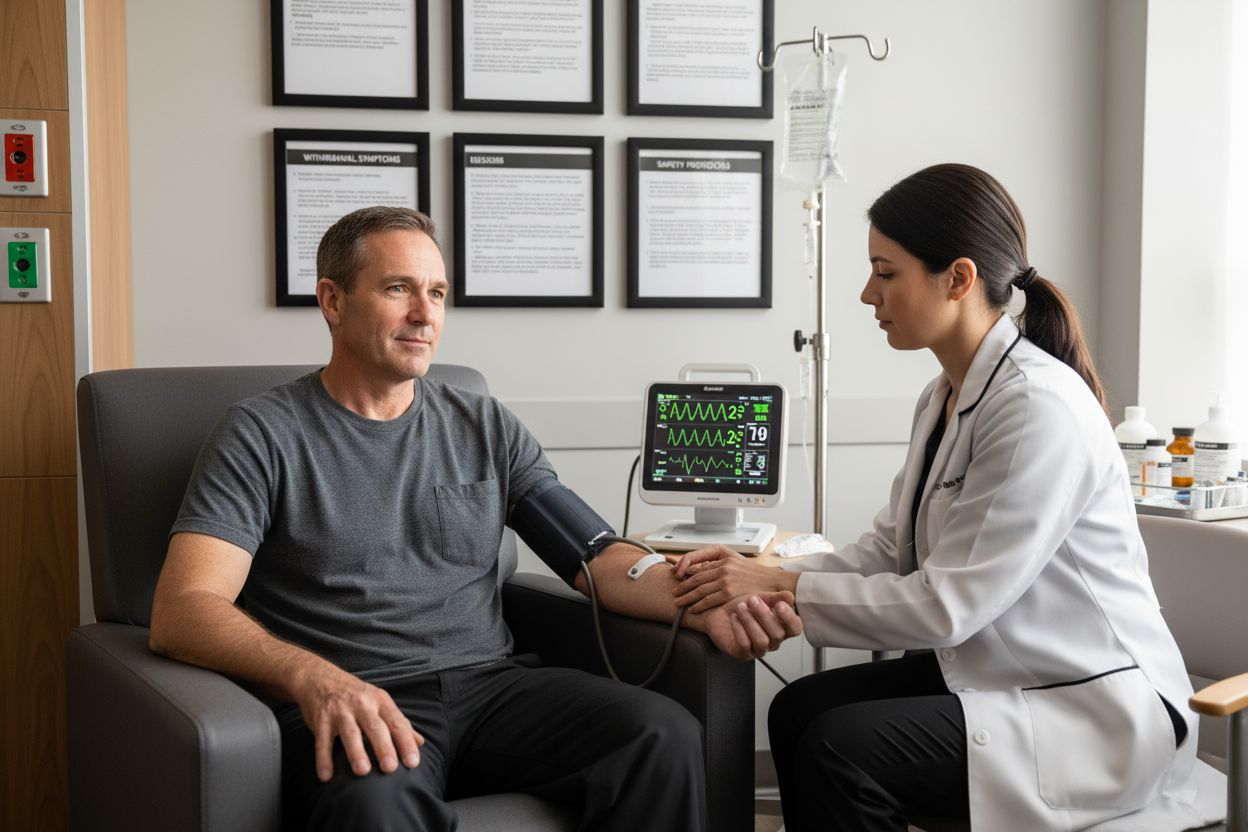Did you know that over 23 million Americans struggle with substance use disorders, yet many misunderstand what drug detox truly involves? Myths about detox can make treatment seem intimidating or even dangerous, which stops many people from getting help. Learning the facts about detox clears away common fears and reveals a safer, more supportive approach to the first step toward lasting recovery.
Key Takeaways
| Point | Details |
|---|---|
| Detox is Just the First Step | Drug detox is not a cure but an essential initial phase of addiction recovery, necessitating ongoing treatment and support. |
| Medical Supervision is Critical | Professional oversight during detox is crucial for managing withdrawal symptoms and ensuring individual safety. |
| Understanding Withdrawal is Key | Withdrawal experiences vary by substance; understanding timelines and potential complications is important for effective management. |
| Aftercare is Essential for Recovery | A solid aftercare strategy significantly reduces the risks of relapse and supports sustainable recovery post-detox. |
Table of Contents
- What Drug Detox Is And Common Misconceptions
- Types Of Drug Detox Methods Explained
- The Detox Process: Stages And Symptoms
- Medical Supervision And Safety In Detox
- Risks, Withdrawal Complications, And Aftercare Resources
What Drug Detox Is and Common Misconceptions
Drug detox represents the critical first phase of addiction recovery, where substances are systematically and safely removed from an individual’s body. Detoxification is far more complex than simply stopping substance use – it’s a medically supervised process designed to manage withdrawal symptoms and prepare individuals for comprehensive addiction treatment.
According to SAMHSA, addiction is a complex brain disease rather than a personal failure of willpower. This understanding is crucial because detox alone is not a cure, but merely the initial step in a comprehensive recovery journey. Many people mistakenly believe that completing detox means they are fully recovered, when in reality, ongoing treatment and support are essential for long-term healing.
Common misconceptions about drug detox can be dangerous and potentially life-threatening. As research from Seacrest Recovery Center highlights, several myths persist:
- Home detox is always safe: False. Medically supervised detox is critical for managing potentially severe withdrawal symptoms
- Detox cures addiction: Incorrect. It’s just the first step in a comprehensive treatment process
- Withdrawal is universally unbearable: Untrue. Professional medical support can significantly manage and mitigate withdrawal discomfort
Understanding these nuances helps individuals approach detox with realistic expectations and increases their chances of successful, sustainable recovery. Professional medical support transforms detox from a potentially dangerous process into a structured, compassionate pathway toward healing.
Types of Drug Detox Methods Explained
Drug detox methods are not one-size-fits-all, but rather a spectrum of carefully designed approaches tailored to individual needs and specific substance dependencies. Medical detoxification represents the most comprehensive and professionally supported strategy for safely managing withdrawal symptoms and preparing individuals for long-term recovery.
According to WebMD, two primary detox approaches exist: cold turkey and tapering. Cold turkey involves abrupt substance cessation, while tapering gradually reduces substance intake, often utilizing medication-assisted treatments to ease withdrawal challenges.
Key Detox Method Categories
- Medically Supervised Inpatient Detox
- 24/7 professional medical monitoring
- Immediate intervention for severe withdrawal symptoms
- Comprehensive care and immediate medical support
- Medication-Assisted Detox
- Uses medications like methadone or buprenorphine
- Specifically designed for opioid withdrawal management
- Reduces withdrawal severity and helps stabilize patients
Research from the National Center for Biotechnology Information highlights advanced techniques like rapid detox and ultra-rapid detox with opioid antagonists. However, medical professionals caution that while these methods exist, their long-term effectiveness remains limited, and safety must be meticulously monitored.
Choosing the right detox method depends on multiple factors: substance type, duration of use, individual health conditions, and personal medical history. Professional assessment ensures the most appropriate, safe, and effective detoxification strategy for each unique individual’s recovery journey.
Here’s a comparison of common drug detox methods:
| Detox Method | Main Features | Best For |
|---|---|---|
| Inpatient Medically Supervised | 24/7 medical care Immediate intervention Comprehensive support |
Severe dependencies High-risk withdrawal |
| Medication-Assisted | Uses medications (e.g., methadone, buprenorphine) Stabilizes withdrawal Reduces symptoms |
Opioid detox Chronic users |
| Cold Turkey | Abrupt stoppage No medication High withdrawal discomfort |
Mild cases Short-term use |
| Tapering | Gradual dose reduction Often medication supported Lower withdrawal risk |
Benzodiazepines Prescription drugs |
| Rapid/Ultra-Rapid | Accelerated withdrawal Opioid antagonists used Requires heavy monitoring |
Specific opioid cases Supervised settings |
The Detox Process: Stages and Symptoms
Detoxification is a complex, challenging journey that varies dramatically depending on the substance and individual physiology. Withdrawal represents the body’s intense process of readjusting to functioning without a previously relied-upon chemical substance, triggering a cascade of physical and psychological responses.
According to Integris Health, withdrawal timelines differ significantly across substances:
- Alcohol Withdrawal
- Begins: 6-12 hours after last drink
- Peak intensity: 24-72 hours
- Potential complications: High medical risk
- Opioid Withdrawal
- Begins: 12-24 hours after last dose
- Peak intensity: Around 72 hours
- Symptoms: Intense physical and psychological distress
Typical Withdrawal Progression
Research from Palmer Lake Recovery reveals that withdrawal typically progresses through distinct stages. Early symptoms often include anxiety, insomnia, and mild physical discomfort. As detox continues, individuals experience peak physical distress characterized by more intense symptoms like tremors, sweating, and heightened emotional volatility.
The late stages of detox can be particularly challenging, with potential medical risks including delirium tremens, organ complications, and lingering psychological symptoms. Professional medical supervision becomes crucial during these stages, as unexpected complications can emerge rapidly. Each person’s detox experience is unique, underscoring the importance of personalized, compassionate medical support throughout the entire recovery process.
Medical Supervision and Safety in Detox
Medical supervision is the cornerstone of safe and effective drug detoxification, transforming what could be a dangerous process into a carefully managed journey toward recovery. Detox is not just about stopping substance use, but ensuring the individual’s physical and psychological well-being throughout the challenging withdrawal period.
According to research from the National Center for Biotechnology Information, specialized medical interventions play a critical role in managing withdrawal symptoms and reducing potential risks. For opioid detox, medications like buprenorphine/naloxone and methadone are strategically used to:
- Minimize severe withdrawal symptoms
- Reduce the risk of overdose
- Provide controlled substance management
- Support gradual, safer withdrawal
Critical Safety Considerations
Medical professionals monitor several key health parameters during detox, including:
- Vital signs (heart rate, blood pressure, temperature)
- Hydration and nutritional status
- Psychological state and emotional well-being
- Potential complications from withdrawal
Especially for substances like benzodiazepines, medical supervision becomes paramount. Professionals implement slow, carefully monitored tapering strategies to prevent potentially life-threatening withdrawal reactions. This approach ensures that the detox process is not only effective but fundamentally safe.
Beyond immediate medical management, supervised detox provides comprehensive support. Trained medical staff can quickly respond to unexpected complications, manage concurrent mental health conditions, and design personalized treatment plans that address each individual’s unique physiological and psychological needs. The goal extends far beyond symptom management – it’s about creating a foundation for sustainable, long-term recovery.
Risks, Withdrawal Complications, and Aftercare Resources
Detox recovery is a complex journey fraught with potential challenges that extend far beyond the initial withdrawal period. Understanding the risks and developing a comprehensive aftercare strategy are crucial for sustainable long-term recovery and preventing potentially life-threatening relapse scenarios.
Research from the National Center for Biotechnology Information reveals significant barriers patients face when transitioning from detox to ongoing care, including:
- Limited treatment availability
- Unstable housing conditions
- Lack of continuous care coordination
- Insufficient support infrastructure
Critical Relapse Risk Factors
Particularly for opioid use disorder, the risks are profound. According to recent studies, patients face heightened vulnerability due to:
- Reduced physiological tolerance after detox
- Increasingly potent street drugs like fentanyl
- Psychological vulnerability during transition
- Potential underlying mental health challenges
Aftercare Strategy Recommendations
Research from PMC demonstrates that continuing care significantly reduces relapse and overdose risks. Effective aftercare typically involves:
- Regular counseling sessions
- Support group participation
- Medication-assisted treatment monitoring
- Comprehensive mental health support
- Relapse prevention planning
Successful recovery requires a holistic approach that addresses not just physical dependency, but the complex psychological and social factors contributing to substance use. Professional aftercare resources can transform the challenging post-detox period into a structured pathway toward sustainable healing and personal transformation.
Take the Next Step Toward Safe and Supported Drug Detox
Understanding the realities of drug detox can be overwhelming, especially when facing fears about withdrawal symptoms and the uncertainty of what comes after detoxification. The challenges discussed in the article—such as the dangers of detoxing without medical supervision, misconceptions about recovery, and the crucial need for continuous care—highlight why professional guidance and compassionate support are so important for true, long-term wellness.
At Glendora Recovery Center, we deliver the specialized medical care and ongoing support you need for every step of your recovery, from supervised detox to aftercare and relapse prevention. If you or a loved one are looking for a path forward that addresses not just physical withdrawal, but also the emotional and psychological aspects of addiction, explore our detox services and full continuum of care. Our team can help you transition from uncertainty to hope. Contact us at Glendora Recovery Center today for personalized guidance and discover how a safe and supportive environment can transform your recovery journey.
Frequently Asked Questions
What is drug detox and why is it important?
Drug detox is the initial phase of addiction recovery where substances are safely removed from the body under medical supervision. It is important because it helps manage withdrawal symptoms and prepares individuals for long-term addiction treatment.
What are the common misconceptions about drug detox?
Common misconceptions include the belief that detox cures addiction, that home detox is safe, and that withdrawal symptoms are universally unbearable. Understanding these misconceptions can lead to more realistic expectations during the recovery process.
What are the main types of drug detox methods?
The main types of drug detox methods include inpatient medically supervised detox, medication-assisted detox, cold turkey, tapering, and rapid/ultra-rapid detox. Each method is tailored to individual needs based on factors like substance type and personal health conditions.
Why is medical supervision critical during the detox process?
Medical supervision is crucial during detox as it ensures the individual’s safety by monitoring vital signs, managing withdrawal symptoms, and addressing potential complications. Supervised detox also provides comprehensive support and prepares individuals for successful recovery.




